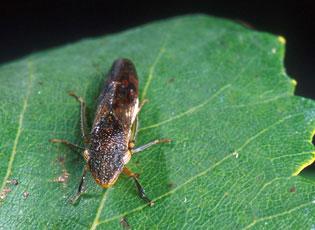Homalodisca vitripennis (Germar) (Formerly known as Homalodisca coagulata) (Takiya et al. 2006)
Glassy-winged sharpshooter (GWSS), xylophagous leafhopper
Southeastern U.S. (Hoddle et al. 2003)
Introduced to California by 1990 (Blua et al. 1999)
Probably arrived in California on nursery stock from the southeastern U.S. (Blua et al. 1999)
Vector of Pierce's disease (lethal disease of grapevines) (Blua et al. 1999)

Glassy-winged sharpshooter on a grape leaf
Peggy Greb USDA, Agricultural Research Service
Distribution / Maps / Survey Status
Videos
All Resources
Selected Resources
The section below contains highly relevant resources for this species, organized by source.
Council or Task Force
Partnership
International Government
State and Local Government
Hoddle, M.S., S.V. Triapitsyn, and D.J. Morgan. 2003. Distribution and plant association records for Homalodisca coagulata (Hemiptera: Cicadellidae) in Florida. Florida Entomologist 86(1):89-91.
Takiya, D.M., S.H. McKamey, and R.R. Cavichioli. 2006. Validity of Homalodisca and of H. vitripennis as the name for glassy-winged sharpshooter (Hemiptera: Cicadellidae: Cicadellinae) Annals of the Entomological Society of America 99(4):648-655.
